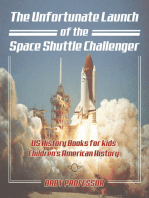Notes 3
Uploaded by
Prabal SahaNotes 3
Uploaded by
Prabal SahaDART mission notes
“All of us have a responsibility to protect our home planet. After all, it’s the only one we
have. This mission shows that NASA is trying to be ready for whatever the universe throws
at us. NASA has proven we are serious as a defender of the planet. This is a watershed
moment for planetary defence and all of humanity,” said NASA chief Bill Nelson in a press
statement.
Before the crash, NASA put down the minimum definition of success as an orbital period change of
73 seconds or more. At the time, Dimorphos took about 11 hours and 55 minutes to orbit the larger
asteroid Didymos. After the crash, DART teams have confirmed that the impact shortened the orbit
b 32 minutes, with it now Dimorphos now taking only 11 hours and 23 minutes to orbit the larger
asteroid. DART surpassed the minimum benchmark by more than 25 times.
Note 2:
The Stratospheric Observatory for Infrared Astronomy (SOFIA) was a mission of discovery,
revealing unseen – and sometimes unseeable – parts of our universe. As the mission draws to a
close, with flights ending on Thursday, Sept. 29, NASA is taking a look back at the scientific
accomplishments of SOFIA and some of the feats of engineering that let it fly.
“From deepening our understanding of water on the Moon to revealing the invisible forces of
cosmic-scale magnetic fields, none of it could have happened without the hundreds of people
who contributed their expertise to the SOFIA mission,” said Naseem Rangwala, the mission’s
project scientist at NASA's Ames Research Center in California's Silicon Valley.
From the start of its development in 1996, SOFIA required engineering ingenuity. A Boeing
747SP jetliner had to be modified to carry the 38,000-pound, 100-inch (more than 17,000-
kilogram, 2.5-meter) telescope provided by NASA’s partner on the SOFIA mission, the German
Space Agency at DLR.
Engineers at Ames developed a garage door-like mechanism that rolled up to let the telescope
observe the skies. In that configuration, it was “one of the largest open ports ever flown on an
aircraft,” said Paul Fusco, a NASA engineer, now retired, who helped design the door
system, “and the largest certified to fly at all altitudes and speeds with the door open. It was a
really thrilling aviation innovation.”
You might also like
- NASA Facts SOFIA-NASA's Stratospheric Observatory For Infrared AstronomyNo ratings yetNASA Facts SOFIA-NASA's Stratospheric Observatory For Infrared Astronomy2 pages
- Double Asteroid Redirection Test: Defending Earth from AsteroidsFrom EverandDouble Asteroid Redirection Test: Defending Earth from AsteroidsNo ratings yet
- 2021 November Newsletter - Draft November 29eNo ratings yet2021 November Newsletter - Draft November 29e100 pages
- Mars Rover: How a Self-Portrait Captured the Power of CuriosityFrom EverandMars Rover: How a Self-Portrait Captured the Power of CuriosityNo ratings yet
- Space Shuttle Stories: Firsthand Astronaut Accounts from all 135 MissionsFrom EverandSpace Shuttle Stories: Firsthand Astronaut Accounts from all 135 Missions4.5/5 (3)
- Summary of Challenger by Adam Higginbotham: A True Story of Heroism and Disaster on the Edge of SpaceFrom EverandSummary of Challenger by Adam Higginbotham: A True Story of Heroism and Disaster on the Edge of SpaceNo ratings yet
- On Mars: Exploration of the Red Planet, 1958-1978--The NASA HistoryFrom EverandOn Mars: Exploration of the Red Planet, 1958-1978--The NASA HistoryNo ratings yet
- The Unfortunate Launch of the Space Shuttle Challenger - US History Books for Kids | Children's American HistoryFrom EverandThe Unfortunate Launch of the Space Shuttle Challenger - US History Books for Kids | Children's American HistoryNo ratings yet
- The Double Asteroid Redirection Test: LaunchNo ratings yetThe Double Asteroid Redirection Test: Launch2 pages
- Comets and Asteroids in Action (An Augmented Reality Experience)From EverandComets and Asteroids in Action (An Augmented Reality Experience)No ratings yet
- Nasa Secrets the Story of the Space Shuttle Vehicles— Launching SatellitesFrom EverandNasa Secrets the Story of the Space Shuttle Vehicles— Launching SatellitesNo ratings yet
- Expedition Deep Ocean: The First Descent to the Bottom of All Five of the World's OceansFrom EverandExpedition Deep Ocean: The First Descent to the Bottom of All Five of the World's Oceans3/5 (6)
- Hubble Deep Field: How a Photo Revolutionized Our Understanding of the UniverseFrom EverandHubble Deep Field: How a Photo Revolutionized Our Understanding of the UniverseNo ratings yet
- Returning to the Moon: A Max Axiom Super Scientist AdventureFrom EverandReturning to the Moon: A Max Axiom Super Scientist AdventureNo ratings yet
- Numeric Data Movement - To A COMP VariableNo ratings yetNumeric Data Movement - To A COMP Variable40 pages




































































